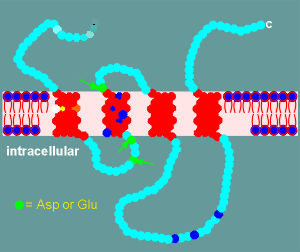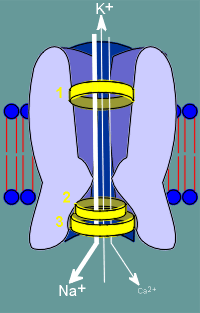the ion filter domain
 It was noted that there were glutamic acids and
aspartic acids, with their negative charged side groups, in each of the alpha, beta, gamma
and delta subunits, near the regions where the 25 hydrophobic amino acids cross the
membrane for the second transmembrane region (arrows figure at right, for alpha subunit).
It was noted that there were glutamic acids and
aspartic acids, with their negative charged side groups, in each of the alpha, beta, gamma
and delta subunits, near the regions where the 25 hydrophobic amino acids cross the
membrane for the second transmembrane region (arrows figure at right, for alpha subunit).
Lining up this region for the alpha, beta, gamma and delta
subunit, gave rise to the idea of a ion filter.
This is depicted in the figure below, where the
transmembrane region of each subunit is shown as a red bar, the glutamic and aspartic
acids are represented by the green balls and other amino acids by the light blue balls.
 As it turns out, there are
three alignments of the acetic amino acids, one on the extracellular side and two on the
intracellular side.
As it turns out, there are
three alignments of the acetic amino acids, one on the extracellular side and two on the
intracellular side.
This leads to three rings of negatively charged amino
acids (shown in yellow) that help form the cation specificity of the nicotinic receptor.
The nicotinic receptor is permeable to most cations, such as
Na+, K+ and Ca2+, although monovalent cations are selectively preferred.
 The
ions flow according to their electrochemical equilibrium points, and thus Na+ flows in and
K+ flows out.
The
ions flow according to their electrochemical equilibrium points, and thus Na+ flows in and
K+ flows out.
Na+ is by far the most important component for the nicotinic
receptor and its influx results in a depolarization of the cell.
interesting fact about the ion filter
In fact, Numa and coworkers failed to recognize the presence
of the ion filters. The idea of the filter came about when the GABAa receptor (a chloride
channel) was sequenced (sequenced shortly after the nicotinic receptor).
It was noted that the subunits of the GABAa receptor had a
high sequence homology with the nicotinic receptor with one highly interesting
exception...the aspartic acids and glutamic acids of the nicotinic receptor were
substituted for arginines and lysines, basic amino acids with "+" charges.
The idea developed from this observation was that the
"-" charges of the nicotinic receptor would act as an ion filter for cations and
the "+" charges found in the GABAa receptor would act as an ion filter for
anions such as the chloride ion.
 It was noted that there were glutamic acids and
aspartic acids, with their negative charged side groups, in each of the alpha, beta, gamma
and delta subunits, near the regions where the 25 hydrophobic amino acids cross the
membrane for the second transmembrane region (arrows figure at right, for alpha subunit).
It was noted that there were glutamic acids and
aspartic acids, with their negative charged side groups, in each of the alpha, beta, gamma
and delta subunits, near the regions where the 25 hydrophobic amino acids cross the
membrane for the second transmembrane region (arrows figure at right, for alpha subunit). As it turns out, there are
three alignments of the acetic amino acids, one on the extracellular side and two on the
intracellular side.
As it turns out, there are
three alignments of the acetic amino acids, one on the extracellular side and two on the
intracellular side. The
ions flow according to their electrochemical equilibrium points, and thus Na+ flows in and
K+ flows out.
The
ions flow according to their electrochemical equilibrium points, and thus Na+ flows in and
K+ flows out.